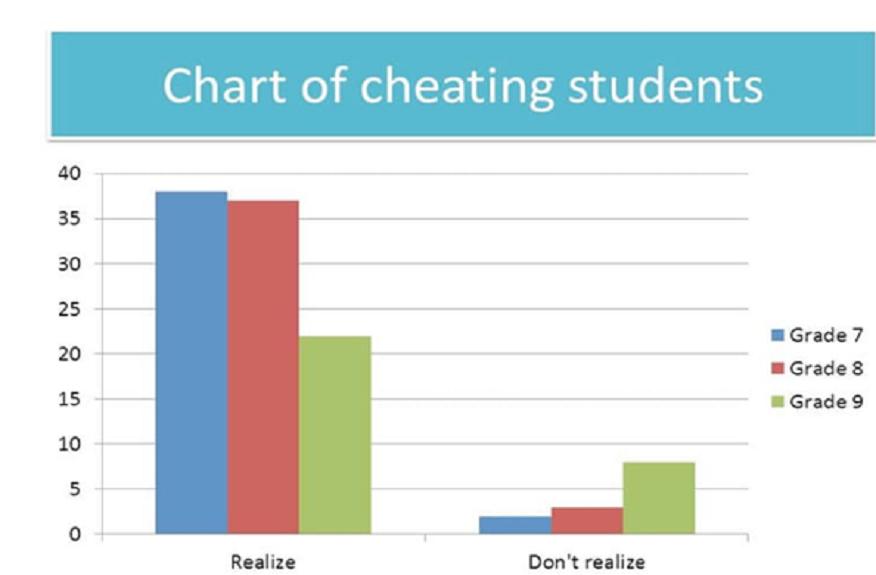One of the long-standing issues that every school teacher faces are that students are cheating their way out to clear their exams or any test. According to essay.ws one survey, it has been found out that most of the students realize that they are cheating and do it consciously, and on the other hand there are few students that don’t even realize that they build a habit of cheating in exams.

Source: essay.ws
However, the question that arises is why any student cheat. There could be several factors like- performing better in their academics to score good grades, with time education getting more competitive, they might not find the topic interesting, etc.
The problem of cheating in exams is there in the education system for a very long time and it seems like there’s no effective solution, but teachers who have pursued courses like a teacher training course in Singapore, know how to tackle the problem of cheating in the classroom effectively.
However, this blog post will also help you to maintain the integrity of your classroom, by implementing certain effective strategies, which have been mentioned below to prevent cheating in the classroom.
So, without any further ado, let’s get started.
Effective Strategies to Prevent Strategies in the Classroom
1. Educate Students about Integrity and Being Honest
One of the fundamental steps in preventing cheating is to have open discussions about honesty and integrity with students. By discussing these concepts, teachers can reinforce the importance of academic integrity and remind students of their ethical responsibilities.
While students may already be familiar with these concepts, it is crucial to relate them specifically to the classroom environment. By setting clear expectations and emphasizing the value of integrity, teachers can discourage students from resorting to cheating.
2. Create Different Versions of Assessments
To combat cheating during tests and assessments, teachers can create multiple versions of the same assessment. This can be done by rearranging the order of questions or re-wording them for different versions.
By doing so, teachers can identify students who have copied answers from others by comparing their responses to the different versions. Teachers can choose to inform students about the use of multiple versions as a deterrent or keep it discreet to catch cheaters off guard.
3. Use Formative & Summative Assessments
Another effective strategy is to incorporate a variety of assessment styles. By balancing the use of formative and summative assessments, teachers can reduce the pressure on high-stakes exams, which often tempt students to cheat.
Formative assessments, which occur throughout the course, provide valuable feedback on student progress, while summative assessments measure overall learning. By emphasizing the importance of both types of assessments, teachers can alleviate the motivation to cheat based solely on grades.
4. Manage Access to Personal Devices
Cell phones and other personal devices can provide opportunities for cheating. To address this, teachers can establish rules regarding the use of devices during testing. Some teachers require students to place their phones face-down on their desks or in designated areas like a drawer or basket.
Alternatively, teachers can turn this into a benefit by providing a charging station where students can safely store their phones during class. Consistent enforcement of these rules helps minimize the temptation to use devices for cheating purposes.
5. Review Settings on Digital Study Tools
Students may attempt to exploit study resources, such as account-based platforms like Quizlet, for cheating purposes. To prevent this, teachers should review the settings of any external study tools used in the classroom.
This includes checking privacy settings and accessibility controls to ensure that the resources are only accessible to authorized individuals. By reviewing and controlling these settings, teachers can mitigate the risk of unintentionally facilitating cheating through online study resources.
6. Re-design Test Structures
Standardized testing often relies heavily on multiple-choice questions, which can make cheating easier. To address this, teachers can incorporate more open-ended questions that require critical thinking skills. By posing questions that cannot be easily copied or memorized, teachers can discourage cheating and encourage students to engage in independent thought. Identical answers from students sitting next to each other would be a clear indicator of cheating.
7. Rotate Seating Arrangements on Test Day
In some cases, students sitting together may collaborate to cheat during tests. To prevent this, teachers can implement a seating rotation policy on test days. By assigning students to different seats for each test, teachers can disrupt established cheating patterns. It is advisable to keep the seating changes a surprise to prevent students from making plans to cheat. This strategy minimizes the likelihood of students sharing answers and encourages individual accountability.
8. Cultivate an Inclusive Learning Environment
Creating a classroom environment where students feel comfortable asking questions is essential in preventing cheating. Encouraging students to ask for help, express their opinions, and engage in critical thinking promotes active learning.
Teachers can achieve this by adopting a teaching style that welcomes questions and values effort and progress over grades. By emphasizing the importance of learning and personal growth, teachers can reduce the incentive for students to cheat for the sake of achieving high grades.
9. Redefine Success Definition in the Classroom
Shifting the focus from grades to personal growth and effort can significantly impact the prevalence of cheating. Praising students for their effort and progress rather than solely for their grades fosters intrinsic motivation and a desire to learn.
By acknowledging and appreciating the hard work of every student, teachers create an environment where cheating becomes less appealing. This approach encourages students to take ownership of their learning and disassociates success from a numerical grade.
Implementation of Effective Strategies Can Prevent Cheating
Cheating is one of the most common problems that lie in the education system since anyone can remember. Every teacher has to face this problem in their classroom. However, those teachers who have pursued courses like teacher training course in Singapore , know how to tackle effectively of cheating in the classroom effectively.
Moreover, our blog post contains many effective strategies to prevent cheating that any teachers can implement in their classroom to maintain the integrity of not just of the classroom but also of the whole school.






